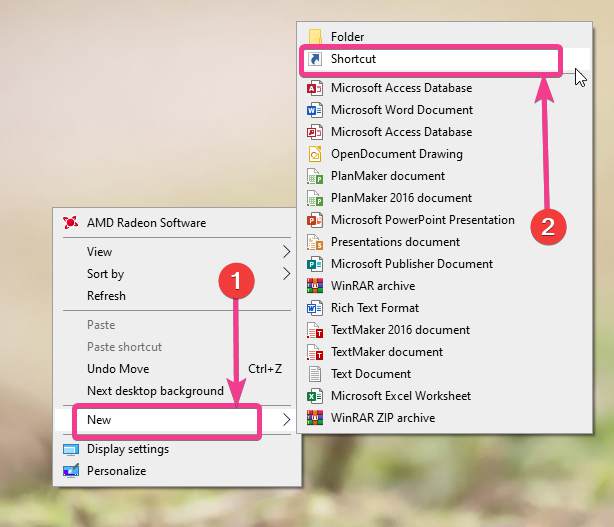
- #HOW TO CREATE A SHORTCUT ON DESKTOP ON WINDOWS 7 HOW TO#
- #HOW TO CREATE A SHORTCUT ON DESKTOP ON WINDOWS 7 PLUS#
- #HOW TO CREATE A SHORTCUT ON DESKTOP ON WINDOWS 7 WINDOWS 7#
- #HOW TO CREATE A SHORTCUT ON DESKTOP ON WINDOWS 7 WINDOWS#
Figure D This particular action will need no arguments.
#HOW TO CREATE A SHORTCUT ON DESKTOP ON WINDOWS 7 WINDOWS#
Click OK to save and dismiss the remaining windows related to the Task Scheduler. If that explicit path does not work, do a search for taskmgr.exe so that you know exactly where the executable is on your system. When the new window opens ( Figure D), make sure Start a Program is selected from the drop-down menu and then enter C:\\Windows\System32\taskmgr.exe in the Program/Script text area. Give the task a simple name like Taskmanager.Ĭlick on the Actions tab of the Create Task window and click New. Fill out the necessary information for running the Task Manager, making sure to check the box for Run with the Highest Privileges. Open the Task Scheduler (type task in the search field and select Task Scheduler from the results) and click the Create Task from the Actions pane on the right side of the window. Here’s how this works: Step 1: Create a scheduled task. There is a way around this thanks to scheduled tasks. There might be instances where this shortcut will cause the User Access Control (UAC) to pop up, requiring yet another click. Stay on top of the latest Microsoft Windows tips and tricks with TechRepublic’s Windows Desktop newsletter, delivered every Monday and Thursday. Figure C You can sort tasks by user by clicking the header of the User tab. Now when you double-click that icon, the Task Manager will open showing tasks being run by all users, as shown in Figure C. Back in the Properties window, click OK, and you’re done. Figure B If you want to change the icon for the shortcut, click on the Shortcut tab and click the Change Icon button.įrom the Advanced window, click Run as Administrator and click OK. When the Properties window opens ( Figure B), click on the Advanced button. Right-click the newly created shortcut and then select Properties. With the shortcut created, it’s time to configure the properties such that the shortcut will open the Task Manager in the desired manner. In the next text field, give the shortcut a name (such as TM All Users) and click Finish. Figure A You can either browse for the executable or just enter the text in this text field. In the resulting window ( Figure A), enter taskmgr.exe in the Type the Location of the Item field and click Next. Right-click the desktop and then click New | Shortcut. The first step is to create the desktop shortcut that will be used to start the application.
#HOW TO CREATE A SHORTCUT ON DESKTOP ON WINDOWS 7 WINDOWS 7#
With that in mind, let’s create both a desktop icon and a hot key to start the Windows 7 Task Manager automatically showing All Users.

But who wants to take that extra step when the day is already filled with too many headaches and tasks? There is a button in the Windows 7 Task Manager that will close and reopen the Task Manager with the processes listed for all users. It’s not terribly challenging, and the end result is quite useful. In order to add this helpful column to the Task Manager report, a few steps must be taken. Whether to kill a rogue application, check memory consumption, or check running processes, that tool is often the go-to tool for system administrators or support staff.īut there are times, troubleshooting for example, when it is necessary to see the processes that have been executed by all users (and not just the logged-in user). The Windows Task Manager is a tool that is used quite often, for a lot of reasons.
#HOW TO CREATE A SHORTCUT ON DESKTOP ON WINDOWS 7 HOW TO#
Jack Wallen explains how to create a desktop icon to start the Windows 7 Task Manager automatically displaying processes for All Users.
But in Windows 7 you can just hold down the Windows logo key and the Pause key.Quick Tip: Create a shortcut to open Windows 7 Task Manager in All Users view If you want to know your PC’s system information such as what processor you’re using, how much RAM you have, or if your operating system is 32- or 64-bit you could click the Windows Start button–>Control Panel–>System and Security–>System. If you are on a dual monitor setup using Windows 7, you can press Win+Shift+Left or Right arrow key to move the active application window to the left or right monitor.
#HOW TO CREATE A SHORTCUT ON DESKTOP ON WINDOWS 7 PLUS#
Holding the Windows logo key and the plus (+) or minus (-) key allows you to zoom in or zoom out of any application.ĭual Monitors: Win+Shift+Left/Right Arrow Key to Move Active Window to Left or Right Monitor

a blank Word doc or new Firefox browser session).

Holding Shift and the Windows logo key and the number corresponding to the location of the app on the taskbar will open a new instance of that application (i.e. Pressing the Windows logo key and the number corresponding to the location of the app on the taskbar will open and minimize that app.


 0 kommentar(er)
0 kommentar(er)
